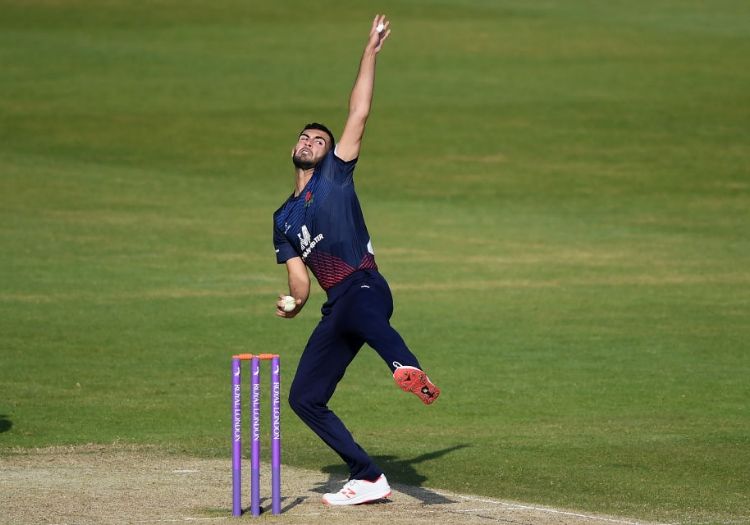NICK FRIEND picks his Royal London One-Day Cup select XI from across the 18 counties after Somerset defeated Hampshire in the final to win the competition for the first time since 2001

James Vince (Hampshire)
509 runs at 72.71, 110.89 SR
The importance of the Hampshire skipper to his county was only further reinforced on Saturday by his controversial absence from the final of a tournament that – until then – he had dominated. A superb 190 against Gloucestershire was the highlight of a campaign that plundered 509 runs in just seven innings.
Whatever the ICC regulations behind his enforced exclusion from the Lord’s showpiece, it was a misfortune that left his team short at the top of the order.
Without his calm disposition and the aura that he carries in the domestic game, his side looked short at the top of the order – when Hampshire were reduced to 50-3, it highlighted everything that Vince adds. As he made a delicate 64, ironically, at the Ageas Bowl in England’s World Cup warmup defeat to Australia, it was hard to wonder how such a situation had been allowed to develop.
Tom Banton (Somerset, wicketkeeper)
454 runs at 41.27, 94.58 SR
While five batsmen managed more runs in the competition than young Tom Banton, none were more eye-catching than the 20-year-old. For the former England Under-19 wicketkeeper, this last month may be worth framing – the platform from which he announced himself as a future star of English cricket.
There is a touch of Kevin Pietersen and more than a spot of Jos Buttler – another keeper with Somerset roots – about Banton’s batsmanship. Swashbuckling, fearless, unorthodox, entirely in keeping with the direction of English one-day cricket’s travel, it is a question of when – rather than if – Banton secures further honours.
A tournament strike-rate of 94.58 and an average of 41.27 are testament to a measure of consistency rarely found in one so inexperienced. That it all came to a head at Lord’s – with a 67-ball 69 – was an entirely appropriate conclusion.
The final that ended an era: List A cricket's goodbye to Lord's leaves bitter taste
Cam Bancroft (Durham, overseas)
377 runs at 94.25, 95.44 SR
Few overseas players can have arrived under as much pressure as Cam Bancroft. Inextricably linked to the ball-tampering scandal of 2018 and a subsequent deal with Somerset cancelled, he arrived in England – and at Durham – with an enormous point to prove.
That Durham were left bemoaning a mixture of rank bad luck and even worse weather sums up quite how well Bancroft, as captain and key batsman, performed in a young side.
Dismissed just four times in the competition, his 377 runs came at a Bradman-esque average of 94.25. He had began with an unbeaten 151 on debut – a show of determination to shut up the critics and a display of no little skill.
Ultimately, however, it was only the rain that stood in his way of leading his team of underdogs and outsiders through to the playoff stage. Ultimately, two successive washouts left his charges level on points with third-placed Lancashire, but with one fewer win.
Cruel luck, but a victory of sorts for the Australian.

Bancroft had a terrific competition and may well have led Durham into the knockout stage with better weather.
Dane Vilas (Lancashire)
439 runs at 62.71, 119.61 SR
What a signing the South African wicketkeeper has been for the Red Rose county. Tough, gutsy, a fine leader and, perhaps, a far more skilled batsman than many had previously given him credit for.
A sum of 439 runs at an average upwards of 62 would seemingly give credence to that statement. His Royal London zenith actually came in a losing cause on a day when 823 runs were scored at Trent Bridge.
Alongside Steven Croft, who smashed 110, Vilas made 166 as Lancashire fell just 11 runs short of Nottinghamshire’s 417. Truth be told, Vilas will think he should have seen his side home. That, though, is to split hairs.
James Hildreth (Somerset)
457 runs at 45.7, 98.49 SR
You would have to have a heart of stone to begrudge James Hildreth his moment in the Lord’s sun. Thirty-four years of age and showing no signs of slowing down, there are few on the county circuit more deserving of domestic honours. That his stock has never been given the opportunity to rise internationally will forever remain one of the great mysteries of this era of English cricket.
No century for Hildreth in this year’s competition, just a load of the same old consistency that he has rarely failed to offer the county he has represented since 2002. A high score of 93 will likely frustrate a supremely talented middle-order stalwart, one of four fifties that took him to 457 runs in this year’s glorious run to the title.
For so long talked up as a viable option in England’s faltering red-ball middle order, his one-day prowess has often fallen under the radar. A season strike rate of 98.49 suggests that, as has been the case so often with Hildreth, his ageless talents continue to be underestimated.

David Wiese's 171 against Hampshire was one of the great one-day knocks on English soil.
Liam Dawson (Hampshire)
274 runs at 45.66, 102.62 SR; 18 wickets at 20.33, 4.11 ER
Logic dictates that James Vince’s absence on Saturday was always going to steal the majority of the headlines; the captain, the eye-catching run-machine, the top-order linchpin. However, ask a range of Hampshire fans for who proved the greater miss and – I’d suggest – Liam Dawson’s name will crop up nearly as often as his skipper’s.
If Vince was the fulcrum of many of Hampshire’s big scores, then Dawson was the key cog in his team’s engine-room; 274 runs at 45.66 tells only half the story. With 18 wickets at an average of 20.33, he offered a level of control that perked the interest of Ed Smith – much to the detriment of Joe Denly.
His economy rate of 4.11 was lower than anyone in the competition who took nine wickets or more. And for all of Mason Crane’s immense talent, Dawson is a tighter, more consistent performer, given his art as a finger-spinner.
While England fans may look at him as an underwhelming worst-case scenario alternative to either Moeen Ali or Adil Rashid, the Hampshire faithful are well aware of his significance.
VISIT THE COUNTY HUB: Your one-stop shop for English domestic cricket
David Wiese (Sussex)
395 runs at 98.75, 120.42 SR; 6 wickets at 62.33, 6.13 ER
Big David Wiese hits a big ball. If Surrey didn’t know this at the beginning of April, they certainly did once he had pummeled a match-winning unbeaten 92. If Hampshire didn’t know this at the beginning of May, they certainly did once he had finally been dismissed for 171 of the most brutal counter-attacking runs one could wish to witness.
A tournament that brought him 395 runs for just four dismissals at an average of 98.75 and a strike rate north of 120. Fairly peerless stuff, that. That he was on the losing side as Hampshire held their nerve once he had finally departed was an enormous travesty of justice. A necessary reminder that cricket is among the most individual of team games, but a team game nonetheless.
Lewis Gregory (Somerset)
287 runs at 31.88, 141.37 SR; 10 wickets at 43.80, 5.94 SR
Similar to Wiese in many ways, a game is never won until you’ve seen off Gregory – whether with bat or with ball. An ever-improving, all-round cricketer, few hit the ball harder or, indeed, further. In fact, only Nottinghamshire’s Tom Moores hit more tournament sixes than Gregory’s 17.
He is a curious kind of cricketer, the sort that one cannot truly judge through statistics alone. If you were to look down through England’s current setup, Ben Stokes might be his closest comparison – at least, in terms of his qualities as an impact cricketer – the kind who can go from quiet passenger to match-winner in the blink of an eye.
A competition strike rate with the bat of 141.37 shows his immense brutality in the latter stages of an innings, while his haul of just 10 wickets fails to truly do justice to his wider impact with the ball.

Saqib Mahmood dragged his Lancashire teammates into the last four of the competition.
Craig Overton (Somerset)
20 wickets at 20.10, 4.84 ER
If it was brother Jamie who did the damage when it mattered at Lord’s, it was Craig who got Somerset there in the first place. Twenty wickets marks a cracking return for the England all-rounder. Rarely in county cricket has the description of a ‘heavy-ball bowler’ proven so apt.
If the pace out of the hand of the big Devon-born right-armer feels less exciting than his hulking frame should suggest, his speed onto the bat more than makes up for it.
A five-wicket haul against Kent was, perhaps, the personal highlight of a terrific campaign. Only three men took more wickets – two of them are in this composite team; Worcestershire’s Wayne Parnell can count himself mightily unfortunate to miss out.
Nathan Sowter (Middlesex)
25 wickets at 20.84, 5.83 ER
Every one-day team needs a leg-spinner these days. Whether looking to rag the ball from right to left or to deceive their opponents with a flatter, quicker trajectory, there is hardly a side without one these days.
Sowter – an unheralded member of the Middlesex side that reached the playoff game, only to lose against Lancashire – is closer to the latter. He does his work between the lines of leg-stump and off-stump, looking to pin batsmen to the crease. In style, he is more Rashid Khan than Adil Rashid.
Perhaps because of the array of international stars in the London outfit, his name has often flown under the radar, but 25 wickets at 20.84 should go some way to changing that. For a leg-spinner operating in April and May, that is quite some return. Mason Crane was the competition’s next most successful leggie; he took 14 wickets. Three four-wicket hauls and a set of six highlight his extraordinary impact.
Saqib Mahmood (Lancashire)
28 wickets at 18.50, 5.42 ER
Propping up this side could only really be one man. Saqib Mahmood, for so long talked about as a man to be watched, tore up the Royal London One Day Cup. As accurate as he was fast, aggressive and hostile, 28 wickets at 18.50 marks a frightful return for the 22-year-old speedster.
The wider English game will be praying that the Birmingham-born bowler can keep this up. If he can, the nation’s stable of fast men will have a brand-new toy to get excited by.
A strike-rate of a wicket every 20.4 deliveries emphasises his effect on opposition sides – the old adage that fast-bowling does strange things to batsmen. He tore through Middlesex’s top order in the playoff game, having already taken six wickets against Northants and a further five just four days later against Leicestershire, out-bowling James Anderson in the process.